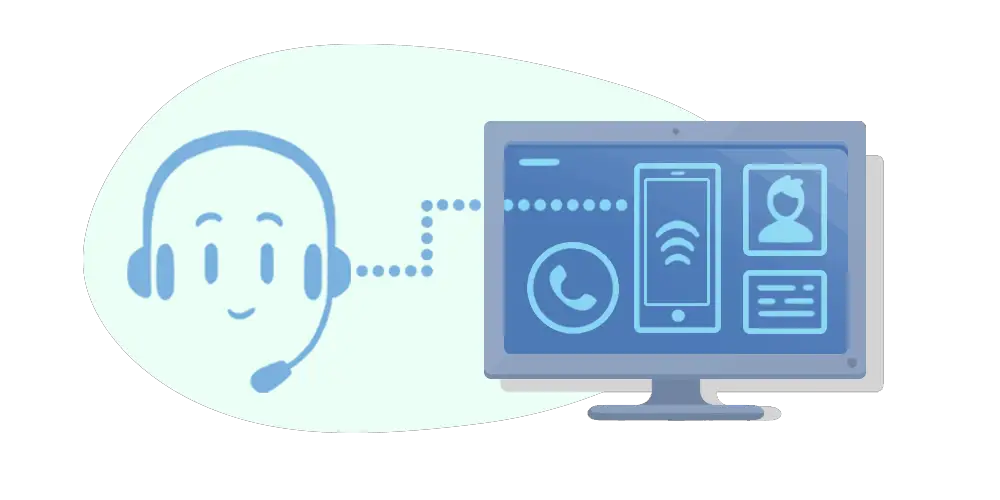Computer-Telephony Integration (CTI) represents a pivotal innovation in communication technology, seamlessly blending telephony with computer systems. This integration has transformed how businesses and individuals communicate, elevating the efficiency and capabilities of telecommunication systems. CTI’s core significance lies in its ability to link telephone systems with computers, enabling a range of functionalities like call routing, caller identification, and integration with customer databases.
Historical Context and Evolution
The concept of CTI emerged in the late 20th century, during an era marked by rapid technological advancements in both computing and telephony. Initially, CTI systems were complex and expensive, primarily used by large corporations with extensive customer service operations. The evolution of CTI closely paralleled advancements in computer hardware and software, becoming increasingly accessible and integrated into everyday business operations. The advent of the internet and digital communication further catalyzed this evolution, leading to modern CTI applications that are integral to numerous industries.

In this article:
- What is Computer-Telephony Integration (CTI)?
- The Evolution of CTI: From Past to Present
- Computer-Telephony Integration in Modern Business Operations
- Integrating CTI with Modern Technologies
- The Future of CTI: Trends and Predictions
- References
1. What is Computer-Telephony Integration (CTI)?
Computer-telephony Integration, also known as CTI, is a general term describing the integration of computer and telephone technologies. By joining computer systems with switched telephone services, users can access advanced functions such as automatic incoming call routing, call display, and power dialing. For example, a computer can use computer-telephony integration (CTI) to issue commands to a telephone switch to control call routing of calls.

CTI encompasses a range of technologies and applications designed to enhance communication capabilities, streamline processes, and improve customer experience in telephonic interactions.
Key Components of CTI
- Telephony System: This includes traditional phone lines (PSTN), VoIP (Voice over Internet Protocol) systems, and PBX (Private Branch Exchange) systems.
- Computer System: Comprising hardware and software, this component runs CTI applications and integrates with other business systems like CRM (Customer Relationship Management) and databases.
- Interface and Middleware: These are crucial for the communication between telephony and computer systems. They include APIs (Application Programming Interfaces) and CTI servers.
- User Interface: This includes dashboards, screen pops, and other tools that allow users to interact with the CTI system, often integrated into existing software applications.
How CTI Systems Work
CTI systems function by establishing a communication bridge between computer and telephone systems. This integration enables several functionalities:
- Call Control Features: Including answering, ending, transferring, and placing calls directly from a computer interface.
- Caller Identification and Routing: CTI systems can identify incoming calls and route them to the appropriate personnel based on predefined rules or caller information.
- Integration with Business Applications: CTI allows for synchronization with business software, enabling features like automatic call logging, accessing customer information during calls, and initiating telephony actions from within applications.
- Automated Dialing and Callback: Systems can automatically dial numbers and schedule callbacks, improving efficiency for tasks like customer outreach or follow-ups.
Through these functionalities, CTI systems have revolutionized communication in various sectors, offering streamlined processes, enhanced customer service, and improved efficiency in telecommunication.
2. The Evolution of CTI: From Past to Present
Historical Perspective of CTI
The journey of Computer-Telephony Integration (CTI) began in the late 1980s and early 1990s, a period characterized by significant technological transformations in both telecommunications and computing. In its early days, CTI was a groundbreaking concept that primarily found application in large-scale corporate environments, especially in sectors like banking and telemarketing. These initial systems were complex and costly, requiring specialized hardware and software.
The primary use of CTI during this era was to enhance customer service operations. Features such as automatic call distribution (ACD), interactive voice response (IVR), and automated attendant services were among the first applications of CTI, aiming to streamline call handling and improve customer interaction.
Technological Advancements Influencing CTI
Over the years, several key technological advancements have significantly influenced the development and adoption of CTI:
- Internet and VoIP Technology: The emergence of the internet and Voice over Internet Protocol (VoIP) technology in the late 1990s and early 2000s revolutionized CTI by allowing telephony to be conducted over the internet, reducing costs and increasing flexibility.
- Cloud Computing: The advent of cloud computing brought about a paradigm shift in CTI. Cloud-based CTI solutions made it possible for businesses of all sizes to implement sophisticated telephony integration without the need for extensive on-premise infrastructure.
- Mobile Technology and Smartphones: With the rise of mobile technology and smartphones, CTI systems have expanded beyond the traditional office setup, enabling remote work and mobile telephony integration.
- AI and Machine Learning: The integration of artificial intelligence and machine learning has further enhanced CTI capabilities, enabling features like predictive call routing, voice analytics, and personalized customer interactions.
3. Computer-Telephony Integration in Modern Business Operations
Role of CTI in Current Business Environments
In the modern business landscape, CTI plays a crucial role in enhancing communication and streamlining operations. Its applications extend across various domains, including customer service, sales, marketing, and internal communications. CTI systems today are more accessible, scalable, and integrated with a broad range of business applications, providing functionalities like click-to-dial, call logging, and real-time customer information access.
Case Studies of CTI Applications in Businesses
- Customer Service Centers: A leading online retailer implemented a CTI system integrated with their CRM platform. This integration provided customer service representatives with immediate access to customer data during calls, significantly reducing call handling times and improving customer satisfaction.
- Sales and Telemarketing: A software company utilized CTI to enhance its sales operations. The CTI system enabled automated dialing and call scheduling, allowing sales representatives to focus more on customer interaction rather than manual dialing.
- Financial Services: A multinational bank integrated CTI with its existing customer service infrastructure. This integration offered advanced call routing based on customer data, ensuring that customers could quickly connect with the most appropriate service representative, thereby enhancing the overall customer experience.
These case studies demonstrate the diverse applications of CTI in modern business operations, underscoring its significance in improving efficiency, customer experience, and operational effectiveness.
4. Integrating CTI with Modern Technologies
CTI’s Integration with Cloud Computing, AI, and IoT
- Cloud Computing: CTI’s integration with cloud computing has opened new avenues for scalability, flexibility, and accessibility. Cloud-based CTI systems allow businesses to deploy telephony solutions that are both cost-effective and highly adaptable to changing business needs. These solutions enable remote work capabilities and easy integration with other cloud-based applications.
- Artificial Intelligence (AI): AI has transformed CTI by introducing advanced features like speech recognition, natural language processing, and predictive analytics. These technologies enhance the customer experience through more personalized and efficient interactions. For instance, AI can analyze call data to optimize call routing and provide real-time assistance to agents during customer interactions.
- Internet of Things (IoT): The integration of CTI with IoT devices extends the capabilities of telephony systems into new domains. IoT devices can trigger automated calls in response to specific events or conditions, enabling applications such as emergency alerts, remote monitoring, and automated customer service updates.
Benefits and Challenges
Benefits:
- Enhanced Efficiency: Automation and AI-driven insights help streamline operations and reduce manual efforts in communication processes.
- Improved Customer Experience: Real-time data and personalized interactions lead to more effective and satisfying customer engagements.
- Scalability and Flexibility: Cloud-based CTI solutions allow businesses to scale up or down based on demand, offering great flexibility.
Challenges:
- Integration Complexity: Integrating CTI with existing business systems can be complex and resource-intensive.
- Security and Privacy Concerns: Handling sensitive customer data and maintaining privacy becomes increasingly challenging, especially with cloud-based and AI-driven systems.
- Keeping Pace with Technological Advancements: Constantly evolving technology requires businesses to stay updated and invest in ongoing training and system upgrades.
5. The Future of CTI: Trends and Predictions
Emerging Trends in CTI
- AI-Driven Personalization: The trend towards personalized customer experiences will continue to grow, with AI playing a key role in analyzing customer interactions and preferences.
- Omnichannel Communication: Integration of CTI with multiple communication channels, including social media, chat, and email, to provide a seamless customer experience.
- Increased Mobility: With the rise of remote work, mobile CTI solutions will become more prevalent, allowing users to access CTI functionalities from anywhere.
Predictions for Future Developments
- Greater Integration with Business Intelligence: CTI systems will likely integrate more deeply with business intelligence tools, providing richer insights into customer behaviors and preferences.
- Enhanced Automation: As AI and machine learning evolve, we can expect more advanced automation in communication processes, reducing the need for human intervention in routine tasks.
- Advancements in Voice Technology: Continued improvements in voice recognition and processing will make voice interactions more natural and efficient.
6. References
- “Computer Telephony Integration” by William A. Yarberry Jr.: A comprehensive guide on the fundamentals and applications of CTI.
- “Voice over IP Fundamentals” by Jonathan Davidson, James Peters, et al.: Provides insights into VoIP technology, a key component of modern CTI systems.
- “Artificial Intelligence: A Guide to Intelligent Systems” by Michael Negnevitsky: Offers an understanding of AI, which is increasingly integral to advanced CTI solutions.
- IEEE Transactions on Communications.